The American Civil War & Irish Nationalism
Published in 18th–19th - Century History, Features, Issue 2 (Summer 1996), The Act of Union, Volume 4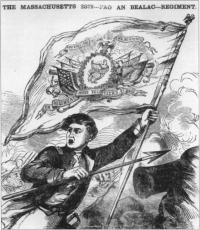
(Boston Pilot,18 January 1862)
It is well known that Irish emigrants to the United States played a significant role in the American Civil War of 1861-65. Individuals such as Patrick Cleburne for the Confederacy, and Philip Sheridan for the North, played important roles in military operations. Even more significant were the tens of thousands of Irish-Americans who fought, plus about 150,000 Irish-born emigrants who joined the Union forces, and 40,000 who fought for the Confederacy.
Yet there is a paradox in the Irish participation—in the North, the section most resistant to the war effort of Lincoln’s Republican government was the Irish-American community. The Irish were easily stirred into resisting radical measures like conscription and the emancipation of slaves. Economic rivalry with black Americans, and an acute psychological need to distinguish themselves from ‘niggers’, made the Irish virulently racist. The worst expression of this was the New York draft riots of 1863 when blacks were murdered in the streets, homes of Irish army officers were attacked, and a black orphanage burned to the ground.
Keen Irish interest in foreign wars
Irish-American resistance to the war effort is explicable in terms of their Democratic allegiance before the war, the rejection of the Irish by the nativist ‘Know-Nothing’ party of the 1850s, plus economic and racist antipathy to blacks. Attitudes to the war in Ireland itself are harder to explain. The Irish in mid-Victorian Ireland took a keen interest in foreign wars. Generally, if Britain was involved, nationalists looked to ‘Ireland’s opportunity’. Otherwise, the Irish were attracted to the side of traditional overseas allies. In 1860, an Irish Brigade of over one thousand men was raised to help the Papal States resist Garibaldi’s invasion. The Catholic church in Ireland was very supportive of the recruitment drive, and the departure and return of the brigade were greeted with general rejoicing. Similarly, in 1870, the invasion of France by Prussia caused an outburst of enthusiasm in nationalist Ireland for assistance to the French Empire. Meetings were held up and down the country, resolutions were passed and men were encouraged to join the French army. Yet in 1861-65, not even a handful of public meetings were held in Ireland to affirm support for the Union, despite the Irishmen fighting in the Federal ranks and the high level of public interest in the war. There was a general consensus, from 1864, within the Catholic Church and the nationalist press, discouraging Union recruitment in Ireland.

The United Irishman and Galway, American,
Published by James Roche, leading light of the Fenian National Brotherhood of St Patrick.
Drift to Confederate support
Before the outbreak of war in April 1861, regret was expressed at the prospect of a break-up of the Union. The reasons for the subsequent drift to Confederate support were many and varied: suspicion of the secular and liberal United States in the ultramontane Irish Catholic hierarchy, disillusion at the loss of Irish lives, the perceived military incompetence of the Lincoln administration, sympathy for secession as a model of Irish rejection of the British-Irish ‘Union’, plus residual bitterness at the ‘Know Nothing’ anti-Catholicism and anti-Irishness of the 1850s.
These reasons, however, are insufficient as a total explanation. Some (ultramontanism, residual bitterness) were general, not particular, causes, and the disillusion at the loss of life among Irish troops suggests an ex post facto justification. Even after 1863 and the Union victories at Gettysburg and Vicksburg, Irish people of all shades of opinion became increasingly Confederate in sentiment. Many who ended up supporting the Confederacy against the North’s coercion, had begun by supporting the Union.
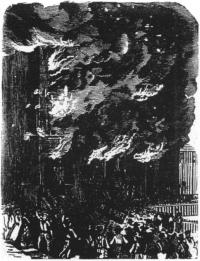
New York’s Orphanage for Coloured Children burns during the 1863 draft riots. The rioters were mainly poor Irish,enraged at what they considered unfair application of draft laws. Their main targets were blacks,recruiting officers and soldiers.
Democratic Party influence
Early responses of Irish nationalists tended to mirror the differing responses within the Democratic Party, in which the Irish were heavily involved. Some followed Thomas Francis Meagher, who abandoned his pre-war support for the South and joined the Union army. Meagher ultimately joined the Republicans as a ‘War Democrat’. Some of the Democrats became ‘Peace Democrats’, or ‘Copperheads’, and conceded the break-up of the Union. Most Democrats adopted a middling position between these extremes. Inflammatory rhetoric often blurred the difference between the Peace Democrats and Democrats generally, but most party spokesmen continued to assert their loyalty to an undivided Union and their hopes for a compromise peace. They contended that a military stalemate existed, and that the ‘old’ Union of 1860, with slavery and states’ rights, could be re-formed by negotiation.
The regret of Irish nationalists at the outbreak of war in 1861 duplicated that of the middle ground of the Democratic Party. However, in the early stages it looked for a time as if the war would produce a pro-Union united front among nationalists similar to the broad support for the Papal States in 1860. This was just after the Trent incident of November 1861, when a US warship stopped a British steamer on the high seas and forcibly removed two Confederate emissaries. It seemed as if war might follow between Britain and the US, an outcome prevented by sensible diplomacy on both sides. In the interim, a nationalist meeting was held in the Rotunda, Dublin, intended to provide the basis for a unified pro-Union organisation. A committee was established to that end, but it was packed with Fenian supporters and was soon abandoned by other nationalist representatives.
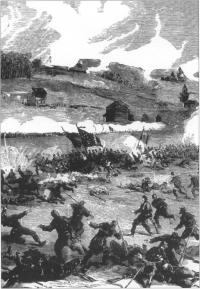
The doomed assault by Union forces on Marye’s Heights,Federicksburg,December 1862. The Irish Brigade suffered forty per cent casualties. Irish nationalist opinion was outraged. Detail of a drawing by Henry Lowe.
Union support—Fenian monopoly
Thus did local Irish politics take precedence over international affairs. It also meant that Union support became somewhat of a Fenian monopoly among nationalists. The losers at the Trent meeting, such as newspaper editors A.M. Sullivan of The Nation and J.S. Maguire MP of the Cork Examiner, reacted by adopting a more cautious approach to the Union cause.
The Fenians were at that moment on the crest of a wave because they had successfully defied Archbishop Cullen and nationalist leaders like Sullivan by organising the massive funeral of Terence Bellew McManus in Dublin in October 1861. The public face of Fenianism was the National Brotherhood of St Patrick which vigorously argued the North’s case, implying strongly that Irish-American soldiers would be available for operations in Ireland after the Civil War. It also traded heavily on an expected outbreak of hostilities between the United States and Great Britain, whose relations were soured by the war. These expectations were fuelled by a growth of jingoistic nationalism in the United States, where newspaper editors like John Gordon Bennett of the New York Herald openly proclaimed that Cuba and Canada should be annexed. The fast-expanding USA was essential as a counterweight to Britain, according to the nationalists who propounded this viewpoint.
In the background of the Irish scene was the clandestine Irish Republican Brotherhood and its leader, James Stephens, who found the National Brotherhood a very useful ‘front’ organisation. There is no doubt that the leadership of the National Brotherhood was complicit in the growth of the IRB. James Roche, its leading light, had been a founder member of the Fenian Brotherhood in New York. He returned to Ireland with the McManus funeral, and stayed on to establish and edit the Galway American. There he became a close friend of William Boxwell West, a native of Wexford, newly arrived in 1861 as US vice-consul in Galway.
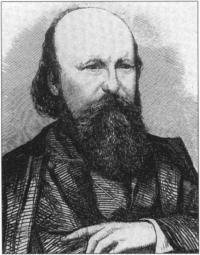
IRB leader James Stephens.
Irish ‘driven to mere slaughter’
The bloody battle of Fredericksburg (December 1862) and the heavy losses suffered by Meagher’s Irish Brigade led most of the nationalist press to the strongest attacks yet on the North’s war policies. Leading newspapers like The Nation and the Cork Examiner claimed the Irish had been ‘driven to mere slaughter’ by an uncaring Lincoln government. Later, in mid-1863, the New York draft riots caused a similar revulsion against the North because they highlighted the apparently unjust application of the conscription law to the Irish poor.
In Britain, radical liberals like John Bright began in early 1863 to agitate for the Union cause by holding mass meetings and generating addresses of support for President Lincoln. In Ireland, James Roche and William Boxwell West tried to score a propaganda coup for the National Brotherhood of St Patrick by engineering their own address to President Lincoln. This was the product of a public meeting at which Roche himself had seconded the proposal. It was forwarded directly to President Lincoln by a disingenuous West, who claimed that as consul in Galway he had a special duty to transmit it. The real reason was that the Dublin consul would have rejected the document out of hand. The whole episode suggests a contrived effort to wring some endorsement for the National Brotherhood from the Lincoln administration. No reply was forthcoming, though West had his knuckles rapped by the State Department for sending the document directly to the President. The incident did not, however, damage West’s career as he was promoted to the Dublin consulate soon after.
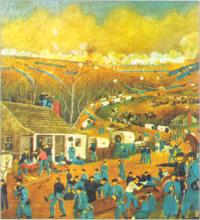
Detail from John Richard’s painting of a scene from the battle of Fredericksburg. Amputations are being performed directly in front of nervous reserves waiting to join the attack.
James Roche also moved to Dublin in the summer of 1863, to commence the publication of the United Irishman and Galway American , successor to the Galway American. Up to this point, the National Brotherhood had been prominent as a Fenian group. The activities of James Stephens and the IRB were known only to relatively few. Despite the fact that it was not a secret oath-bound society, the National Brotherhood attracted widespread clerical condemnation. Its literary and oratorical productions betrayed a strong Chartist influence. Even its support for the Union echoed the viewpoint of John Bright’s English working-class supporters. It was strongest in Dublin and in Britain. Elsewhere in Ireland, its branches were subverted quite early on by the IRB, though this may not have worried the leadership unduly at the time.
The National Brotherhood frequently harked back to 1782, when concessions were wrung from the British government by armed Irish Volunteers, during an American war. In contrast, the IRB’s Irish People, which commenced publication in November 1863, praised the 1798 Rebellion over the ‘compromises’ of 1782 and 1829. Stephens was the guiding force behind the People. Given his dictatorial character, he probably wanted rid of his ‘allies’ in the National Brotherhood, whom he despised, and their rival newspaper.
Stephens’ opportunity came in March 1864 when his followers disrupted a meeting in the Rotunda convened by A.M. Sullivan to protest against the proposed erection of a statue of Prince Albert in College Green. The Times of London scoffed, ‘the American Fenians have scored their first victory on Irish soil’. It seems that some of the IRB men wore Union uniforms, which prompted the singing of ‘Dixie’ by some of Sullivan’s disgruntled supporters. When Roche protested at this interference with free speech in the columns of the United Irishman and Galway American many branches of the National Brotherhood switched to the IRB’s Irish People. Stephens ordered his followers to leave the movement and by August of 1864 the only nationalist group that unequivocally supported the Union had become defunct.
From early 1864 onwards, the country also saw a surge of recruits into the IRB. It became the main Fenian movement in Ireland, under the dictatorial Stephens. The increased numbers stemmed from the success of the Irish People and a recruitment drive under a more effective leadership cadre than that of the National Brotherhood. After the ‘Prince Albert’ fracas, John Devoy was surprised to hear an acquaintance remark admiringly ‘They must be damn sthrong’, and it was this perception that attracted so many into the midnight drills of the IRB.
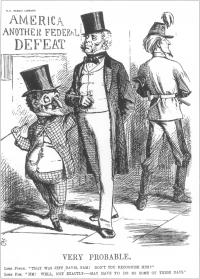
An 1846 Punch cartoon. British flirtation with the Confederacy, and risk of a North Atlantic war, did not produce the expected nationalist pro-Union response, except briefly after the 1861 Trent incident.
Civil War a factor in IRB growth
Much has been written in recent times about military Fenianism as a product of increased socialisation among young men. However, the upsurge in the movement in the early 1860s also took place in the shadow of one of the greatest and longest wars of the century. The increased leisure opportunities of men in urban environments undoubtedly helped the growth of Fenianism, but the particular cause for the growth of the IRB in 1861-65 was the interest and enthusiasm generated by the Civil War. As A.M. Sullivan wrote in his memoirs:
The story was almost universally believed that Mr. Seward had as good as promised certain of the Irish leaders that when the Union was restored America would settle accounts with John Bull, and that Ireland would be gratefully repaid for her aid to the Stars and Stripes. This was the crowning stroke of good fortune for the Fenian leaders.
The Irish People used the Civil War to promote a hero-image of the Irish soldier and created a popular perception which attracted many young men into the IRB. The war, it claimed in December 1863, ‘has restored the Irish people’s weakened confidence in the courage of their hearts and the might of their arms’. On 18 March 1864, the Cork Examiner editorialised against nocturnal ‘drilling and marching’ and its links with America: ‘…all these Federal demonstrations and prophecies are simply ludicrous; but in Ireland they are mischievous in the extreme…the continuance of the drilling and marching policies can only end in individual misery’.
In fact it was the Civil War and the Prince Albert meeting that gave the IRB Fenians ‘a command of Ireland they had never been able to achieve before’, A.M. Sullivan’s description of the effect of the McManus funeral. In particular, the IRB gained temporary leadership of the mass of male artisans—a class excluded from the franchise, but of increasing importance in the dawning era of mass democracy.
Not that the IRB were committed supporters of the North. On the contrary, the leaders hedged their bets on a Union victory. In an insincere manner, they looked to support from the United States but opposed Union recruitment in Ireland, stating firmly that the Irish must stay in Ireland to await American assistance. Thus they avoided the odium that would be attracted by appearing to encourage emigration and Union recruitment. No doubt this helped the IRB to its triumph over the National Brotherhood. As 1864 wore on and Northern casualties rose to unprecedented heights and with no end in sight, the Irish People finally declared that the Civil War was a quarrel ‘with which an Irishman had no concern on earth’. However, as Union victory became inevitable, the earlier heroic picture of the Irish soldier re-emerged.
Association of IRB and Union causes
In spite of the protestations of the Irish People, IRB recruitment and Union recruitment were conflated by the critics of the North. Federal recruitment was opposed not just for the ostensible reason that it was leading men to their doom, but because a Union recruit might return as a threat, an ‘American Fenian’. It was the generally accepted, if not quite accurate, association of the IRB with the Union cause that drove many nationalists like A.M. Sullivan, as well as Catholic clerics like Archbishop Cullen, beyond the position of the Irish-American Democrats and into the pro-Confederate camp. The IRB leaders would also have been quite comfortable with a resolution short of a Union victory, if it would lead to the release of Irish-American soldiers for assistance to Ireland.
Importance of Irish manpower recognised by both sides
Both the Union and Confederate governments recognised the importance of Ireland as a source of manpower. While the North tried surreptitiously to encourage recruits, avoiding violation of Britain’s Foreign Enlistment Act, the Confederacy aimed to deny Ireland to Federal recruiters. Both sides used Irish-American clerics to transmit their messages. Archbishop John Hughes of New York visited Ireland in 1862 on his return from a journey to Rome. Like Meagher, he had been pro-Southern before 1861 but swung his weight behind the Union when war broke out. The earlier part of his mission was a quasi-official visit to the Pope and Emperor Napoleon III to stave off possible recognition of the Confederacy by Catholic powers. In Ireland, Hughes publicly repeated the theme of the inevitably of war between Britain and the USA, stating that, for Irish men, the Civil War was a useful ‘school for warfare’. Unfortunately for his message, Hughes ran into trouble from the Irish clergy when, deliberately or inadvertently, he met a delegation from the National Brotherhood and was then forced to repudiate ‘secret societies’.
A different reception awaited Father John Bannon, a Confederate army chaplain, who visited Ireland in 1864. He was greatly assisted in his mission by John Martin and by Archbishop Paul Cullen of Dublin. Bannon had also been part of a Papal mission, which had produced the most pro-Confederate declaration of any European state. Papal support for the Confederacy weighed heavily with Archbishop Cullen, and sat comfortably with his suspicion of the United States, refuge of the man he regarded as the ‘Irish Mazzini’, Fenian Brotherhood leader John O’Mahony. Bannon later claimed that a broadsheet produced by himself and Martin produced a ‘revolution’ in Irish views. It was widely used by priests in their campaign against recruitment, and against Fenianism. An 1864 Peace Petition, couched in pro-Confederate language, attracted many supporters in Ireland. In Dublin it was left in the porticoes of many churches to encourage signatures.
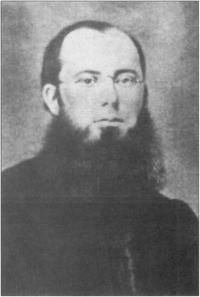
Father John Bannon, a Confederate Army Chaplain, visited Ireland in 1864 to discourage Union recruitment.
Slavery never an issue
The questions of slavery and of freedom for blacks were not major issues in nationalist Ireland. Even the most committed supporters of the North, like James Roche, were unashamedly racist and only grudgingly supportive of abolition. Others, like Sullivan and Martin, belittled Lincoln’s Emancipation Proclamation, and professed to believe that the Confederacy would, in time, abolish slavery of its own volition. The writings of economist John Eliot Cairnes of Queen’s College, Galway, such as his powerful anti-Confederate polemic The Slave Power, were more influential in England than in Ireland.
Conclusion
The onset of the American Civil War found the Irish nationalist polity fragmented and without a clear focus for action. Opinions on the Civil War were confused and often based on the agendas of the contending factions. Confusion was compounded by the divisions among Irish-American Democrats. The length of the war, exceptional for the period, and its swaying fortunes gave plenty of scope for doubts to come to the fore. It was the IRB that shaped the most winning message for the constituency of urban artisans. Stephens, who lacked any great affection for the United States, had the advantage (in 1864) of being able to select the most attractive arguments of both Archbishop Cullen and James Roche, i.e. Union recruitment was discouraged but Irish military prowess was still glorified. However, the sum total of the Irish nationalist position on the American Civil War was that in practical terms it was pro-Confederate.
At the close of the war, the Fenians had 50,000 members in Ireland, and perhaps 50,000 more in the Federal army. However, little thought had gone towards the translation of the organisation’s potential into action. The aftermath of the war was to show up manifold deficiencies in the movement—in organisation, leadership, planning and, not least, military preparation.
After the war, as Joseph Hernon put it, ‘the pro-Southern sympathies of Irish nationalists, and the racist New York draft riots, were all but forgotten.’ A certain irony was present, if unnoticed, when President John F. Kennedy presented a Civil War flag of the ‘Fighting Irish’ 69th New York State Volunteers to Dáil Éireann during his 1963 visit. Sitting in the Dáil were the political heirs of Cullen, Sullivan and Stephens, who had either disowned the Union or hedged their bets. In their presence, the President recalled the motto of the Irish Brigade, ‘The Union, our country and Ireland forever’. With a knowledge of Irish opinion during 1861-65, it could almost be construed a reproach.
Kennedy’s Presidency symbolised that the Irish had finally overcome the anti-Catholic and anti-Irish prejudice exemplified by the ‘Know-Nothings’ of the 1850s. It was the role of Irish people in the Union’s ‘new birth of freedom’ that began the general acceptance of Irish-Americans and provided them with a foundation myth of courage and sacrifice in their new country. The honoured place of the flag of the 69th in the parliament of a sovereign Irish state represents the vindication of people like James Roche, Thomas Francis Meagher, and Archbishop John Hughes, who believed that a strong and undivided United States would be to the ultimate advantage of Irish-Americans and of Irish nationalists generally.
Toby Joyce is a local historian from Galway.
Further reading:
J. M. Hernon, Celts, Catholics and Copperheads: Ireland views the American Civil War (Ohio 1968).
R.V. Comerford, The Fenians in context: Irish politics and society, 1848-82 (Dublin 1985).
T. Joyce, ‘The Galway American’ in Journal of the Galway Archaeological and Historical Society (1995 & 1996).
















